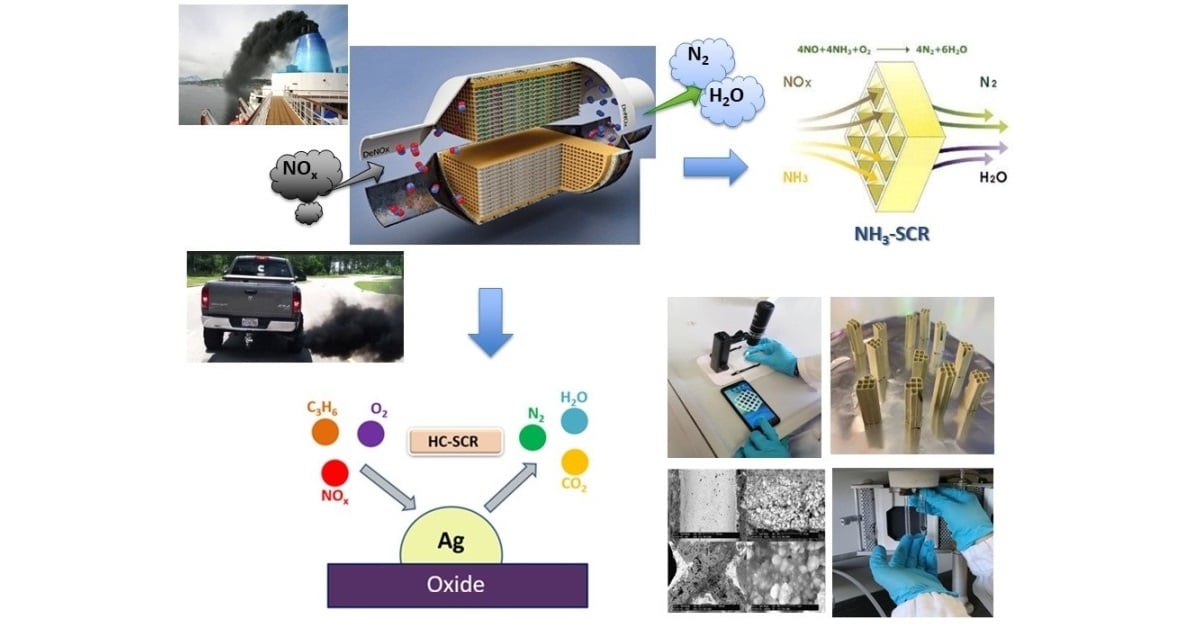NOx, VOCs (Volatile Organic Compounds) and Soot Emission Control in Catalysis, 2nd Edition
A special issue of Catalysts (ISSN 2073-4344). This special issue belongs to the section "Environmental Catalysis".
Deadline for manuscript submissions: closed (15 February 2024) | Viewed by 15018

Special Issue Editors
Interests: heterogeneous catalysis; pollution abatement (deNOx and VOC); temperature-programmed characterization; hydrogen production (dry reforming and partial oxidation of methane); PROX
Special Issues, Collections and Topics in MDPI journals
Interests: supported noble metals; nanostructured and mesoporous oxides; inorganic perovskites; catalytic applications in soot oxidation and NOx SCR of exhaust gases emitted from stationary and mobile sources; VOC oxidation; dry/steam hydrocarbon reforming; CO2 hydrogenation to CH4 and light olefines
Special Issues, Collections and Topics in MDPI journals
Special Issue Information
Dear Colleagues,
This is the second edition of the Special Issue titled “NOx, VOCs (Volatile Organic Compounds) and Soot Emission Control in Catalysis, 2nd Edition”. Nowadays, the emission control in outdoor atmosphere, from diesel and gasoline vehicles, marine engines, fuel powered plants, and as well in indoor environments plays a fundamental role in order to slow down the global warming and preserve human health.
In this context, many governments with new severe legislations are trying to limit the environment pollution impact. Like Euro 7 regulation for vehicles, new standards, such as Tier II (valid outside Emission Control Areas, ECAs) and Tier III (applied only in ECAs) have been issued by the IMO (international maritime organization) of the United Nations in order to regulate NOx emissions for ships. Therefore, new formulations of NO SCR catalysts with high activity and N2 selectivity in the entire range of temperature of exhaust gases are needed. The catalytic performances become highly demanding when the aftertreatment of naval diesel engines fuelled by HFO (heavy fuel oil) is required, due to the high sulphur content.
The importance of catalytic abatement of VOCs, soot and NOx emissions is widely recognized. The goal is to obtain low cost, not toxic and efficient catalytic devices for unburned HC, VOCs and soot catalytic oxidation and for NOx abatement. Due to the limited resources of noble metals and the cost of the current technologies adopted for exhaust gas aftertreatment, it is necessary to find new efficient and cheap catalytic devices.
In this Special Issue, attention is paid to technological innovations to the emissions control from diesel, gasoline and, as well, from de-fossilized fuels powdered engines. The development of catalytic devices to control and purify the air quality indoors, such as in schools, gyms, meeting rooms is another aspect of the present Issue. In situ investigations, such as DRIFT studies or isotopic studies help in understanding the intermediates formation and reaction mechanisms of pollutants abatement. Structural, morphological, redox and electronic characterizations define the relationship between physico-chemical properties and catalytic performances.
Dr. Giuseppe Pantaleo
Dr. Leonarda Liotta
Guest Editors
Manuscript Submission Information
Manuscripts should be submitted online at www.mdpi.com by registering and logging in to this website. Once you are registered, click here to go to the submission form. Manuscripts can be submitted until the deadline. All submissions that pass pre-check are peer-reviewed. Accepted papers will be published continuously in the journal (as soon as accepted) and will be listed together on the special issue website. Research articles, review articles as well as short communications are invited. For planned papers, a title and short abstract (about 100 words) can be sent to the Editorial Office for announcement on this website.
Submitted manuscripts should not have been published previously, nor be under consideration for publication elsewhere (except conference proceedings papers). All manuscripts are thoroughly refereed through a single-blind peer-review process. A guide for authors and other relevant information for submission of manuscripts is available on the Instructions for Authors page. Catalysts is an international peer-reviewed open access monthly journal published by MDPI.
Please visit the Instructions for Authors page before submitting a manuscript. The Article Processing Charge (APC) for publication in this open access journal is 2200 CHF (Swiss Francs). Submitted papers should be well formatted and use good English. Authors may use MDPI's English editing service prior to publication or during author revisions.
Keywords
- VOCs
- soot
- indoor and outdoor pollution
- sensors
- NO SCR by HC or NH3/adBlue
- engine operating conditions
- monolithic and powder catalysts
- supported noble metals
- reducible oxides
- poisoning effects and ageing phenomena
- modelling of catalytic performance
- CO2
- H2O
- SOx effects
Benefits of Publishing in a Special Issue
- Ease of navigation: Grouping papers by topic helps scholars navigate broad scope journals more efficiently.
- Greater discoverability: Special Issues support the reach and impact of scientific research. Articles in Special Issues are more discoverable and cited more frequently.
- Expansion of research network: Special Issues facilitate connections among authors, fostering scientific collaborations.
- External promotion: Articles in Special Issues are often promoted through the journal's social media, increasing their visibility.
- Reprint: MDPI Books provides the opportunity to republish successful Special Issues in book format, both online and in print.
Further information on MDPI's Special Issue policies can be found here.






